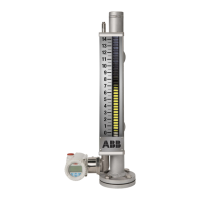5 Mounting
General
Read the following installation instructions carefully before
proceeding. Failure to observe the warnings and instructions
may cause a malfunction or personal hazard. Before installing
the transmitter, ensure the device design meets the
requirements of the measurement point from both a measure
technology and safety point of view.
This applies in respect to:
• Explosion-protection certification
• Measuring range
• Pressure
• Temperature
• Operating voltage
Check the suitability of the materials in regards to their
resistance to the media. This applies to the:
• Gasket
• Process connection and seals
• Float
• Probe
• End connection
In addition, the relevant directives, regulations, standards and
accident prevention regulations must be observed.
Measurement accuracy is largely dependent on the correct
installation of the level transmitter and, if applicable, mounting
arrangement. In instances where it is possible, the measuring
setup should be free from critical ambient conditions such as
large variations in temperature, vibrations or shocks.
NOTICE – Property damage.
If unfavorable ambient conditions cannot be avoided for
reasons relating to building structure, measurement
technology and / or other issues, the measurement quality
may be affected.
All installations
• Prior to installation, verify the model of the transmitter is
suitable for the intended application. Information regarding
the model specifications may be found on the corresponding
LMT Series datasheets.
• The electronics housing should be maintained in the following
ambient conditions:
– Temperature range: –40°C to 85°C (–40°F to 185°F)
– Humidity: 0 to 95% R.H. non-condensing
• Do not use device as a support when mounting
Hazardous area considerations
Only if the certification plate is permanently fixed on the neck
of the transmitter top housing. For specific conditions for safe
use of the LMT100 and LMT200, refer to the LMT Series Safety
Manual (SM LMT100200-EN A).
CAUTION
When the certification plate label is not identified the type
of protection, the user shall,on installation,mark the label
with the type of protection. The certification will be void If
there are more than one type of protection marked on the
label.
IP Protection and Designation
The housing for the LMT Series transmitters is certified as
conforming to protection type IP66 (according to IEC 60529) or
NEMA 4X (according to NEMA 250).
The first number indicates the type of protection the
integrated electronics have against the entry of foreign bodies,
including dust. “6” means that the housing is dust-proof (i.e.,
no ingress of dust). The second number indicates the type of
protection the housing has against the entry of water. “6”
means that the housing is protected against water; specifically,
powerful jets of water under standardized conditions.
Mounting the transmitters
Mounting an LMT100
When mounting the LMT100 level transmitters, the following
rules need to be applied to ensure proper installation:
• Over-tightening the compression tube fitting can cause the
tubing to kink or flare and cause the inside wire to dampen
the return signal.
• When inserting the LMT100, depending on the height, the
user needs to ensure that the float does not drop down on the
float stop or probe end connection. This can cause the end
connection (c-clip) to come off and the float to be lost in the
tank.
• After installing the LMT100, before tightening the
compression fitting, bring the unit up at least 2 inches from
the neck of the housing to the top of the connection.
• When installing the LMT100, be careful to not bend the probe.
This can cause the float to hang-up. For specific conditions
for safe use of the LMT100 and LMT200, refer to the LMT
Series Safety Manual (SM LMT100200-EN A).
• Proceed with the electrical installation(refer to Section 6
“Transmitter Wiring”).

